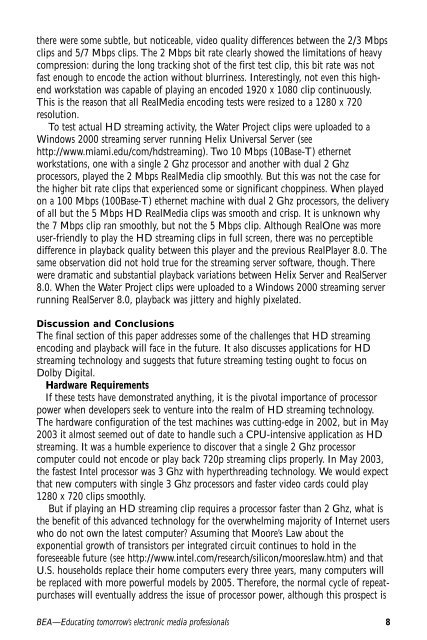JUNEFeedback
Issue 3 - Broadcast Education Association
Issue 3 - Broadcast Education Association
Create successful ePaper yourself
Turn your PDF publications into a flip-book with our unique Google optimized e-Paper software.
there were some subtle, but noticeable, video quality differences between the 2/3 Mbpsclips and 5/7 Mbps clips. The 2 Mbps bit rate clearly showed the limitations of heavycompression: during the long tracking shot of the first test clip, this bit rate was notfast enough to encode the action without blurriness. Interestingly, not even this highendworkstation was capable of playing an encoded 1920 x 1080 clip continuously.This is the reason that all RealMedia encoding tests were resized to a 1280 x 720resolution.To test actual HD streaming activity, the Water Project clips were uploaded to aWindows 2000 streaming server running Helix Universal Server (seehttp://www.miami.edu/com/hdstreaming). Two 10 Mbps (10Base-T) ethernetworkstations, one with a single 2 Ghz processor and another with dual 2 Ghzprocessors, played the 2 Mbps RealMedia clip smoothly. But this was not the case forthe higher bit rate clips that experienced some or significant choppiness. When playedon a 100 Mbps (100Base-T) ethernet machine with dual 2 Ghz processors, the deliveryof all but the 5 Mbps HD RealMedia clips was smooth and crisp. It is unknown whythe 7 Mbps clip ran smoothly, but not the 5 Mbps clip. Although RealOne was moreuser-friendly to play the HD streaming clips in full screen, there was no perceptibledifference in playback quality between this player and the previous RealPlayer 8.0. Thesame observation did not hold true for the streaming server software, though. Therewere dramatic and substantial playback variations between Helix Server and RealServer8.0. When the Water Project clips were uploaded to a Windows 2000 streaming serverrunning RealServer 8.0, playback was jittery and highly pixelated.Discussion and ConclusionsThe final section of this paper addresses some of the challenges that HD streamingencoding and playback will face in the future. It also discusses applications for HDstreaming technology and suggests that future streaming testing ought to focus onDolby Digital.Hardware RequirementsIf these tests have demonstrated anything, it is the pivotal importance of processorpower when developers seek to venture into the realm of HD streaming technology.The hardware configuration of the test machines was cutting-edge in 2002, but in May2003 it almost seemed out of date to handle such a CPU-intensive application as HDstreaming. It was a humble experience to discover that a single 2 Ghz processorcomputer could not encode or play back 720p streaming clips properly. In May 2003,the fastest Intel processor was 3 Ghz with hyperthreading technology. We would expectthat new computers with single 3 Ghz processors and faster video cards could play1280 x 720 clips smoothly.But if playing an HD streaming clip requires a processor faster than 2 Ghz, what isthe benefit of this advanced technology for the overwhelming majority of Internet userswho do not own the latest computer? Assuming that Moore’s Law about theexponential growth of transistors per integrated circuit continues to hold in theforeseeable future (see http://www.intel.com/research/silicon/mooreslaw.htm) and thatU.S. households replace their home computers every three years, many computers willbe replaced with more powerful models by 2005. Therefore, the normal cycle of repeatpurchaseswill eventually address the issue of processor power, although this prospect isBEA—Educating tomorrow’s electronic media professionals 8
















